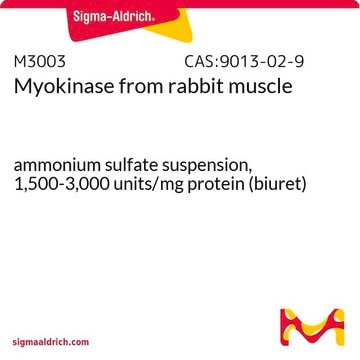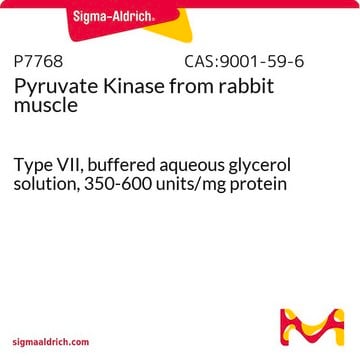P4390
Polynucleotide Kinase from T4-infected Escherichia coli
10 units/μL, buffered aqueous glycerol solution
About This Item
Produtos recomendados
grau
for molecular biology
forma
buffered aqueous glycerol solution
peso molecular
33 kDa
concentração
10 units/μL
atividade externa
Endonuclease and exonuclease, none detected
Condições de expedição
wet ice
temperatura de armazenamento
−20°C
Procurando produtos similares? Visita Guia de comparação de produtos
Aplicação
- Sequencing or nucleic acid tagging (DNA and RNA) by 5′-end labeling
- 5′ phosphorylation of oligonucleotides
- Removal of 3′-phosphate groups from phosphorylpolynucleotides
Componentes
Princípio
1. Forward reaction: Transfer of the labeled γ-phosphate from [γ-32P]-ATP to the free 5′-hydroxyl group of the substrate.
5′-HO-DNA + [γ-32P]-ATP → 5′-32PO-DNA + ADP.
Substrates that do not have a free 5′-hydroxyl require prior dephosphorylation by alkaline phosphatase.
2. Exchange reaction: First, the terminal 5′-phosphate is transferred from the substrate to ADP present in the reaction mixture. Then, the labeled γ-phosphate from [γ-32P]-ATP is transferred to the free hydroxyl group of the substrate.
5′-PO-DNA + ADP → 5′-HO-DNA + ATP
5′-HO-DNA + [γ-32P]-ATP → 5′-32PO-DNA + ADP
Definição da unidade
Nota de análise
produto relacionado
Palavra indicadora
Danger
Frases de perigo
Declarações de precaução
Classificações de perigo
Resp. Sens. 1
Código de classe de armazenamento
10 - Combustible liquids
Classe de risco de água (WGK)
WGK 3
Ponto de fulgor (°F)
Not applicable
Ponto de fulgor (°C)
Not applicable
Equipamento de proteção individual
Eyeshields, Gloves, multi-purpose combination respirator cartridge (US)
Certificados de análise (COA)
Busque Certificados de análise (COA) digitando o Número do Lote do produto. Os números de lote e remessa podem ser encontrados no rótulo de um produto após a palavra “Lot” ou “Batch”.
Já possui este produto?
Encontre a documentação dos produtos que você adquiriu recentemente na biblioteca de documentos.
Nossa equipe de cientistas tem experiência em todas as áreas de pesquisa, incluindo Life Sciences, ciência de materiais, síntese química, cromatografia, química analítica e muitas outras.
Entre em contato com a assistência técnica







